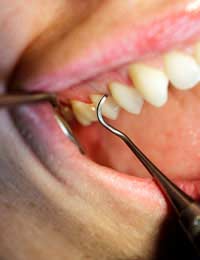Coping With Receding Gums

Receding gums, more technically know as gingival recession, is a condition in which gum tissue is lost and the roots of the teeth are then exposed. Many people are embarrassed about receding gums and feel that their smiles become too “toothy” and the general look of their mouths become wrong. If you are faced with this condition learn what you can about the causes, symptoms and treatments so that you can make the most informed decisions about how to proceed.
Causes of Receding Gums
Gingival recession may have many causes. Some of these causes you may have been able to prevent while others you would have had no control over anyway. Known causes of receding gums include:- Heredity/genes. Up to 30% of the population may be predisposed to receding gums.
- Exuberant tooth brushing, causing enamel to wear away and gums to recede.
- Crooked teeth which do not line up correctly and allow gums to recede.
- Grinding or clenching teeth which forces gums to recede.
- Periodontal diseases which destroy gum tissue.
- Inadequate dental care which allows tartar to build up and push on the gums.
- Hormonal shifts which lead to sensitive gums.
- Tobacco use which leads to plaque build-up on the teeth.
- Lip or tongue piercings which can rub on and wear away the gums.
- Eating disorders which include vomiting and excessive acid in the mouth.
- Sensitivity to toothpaste ingredients which causes sensitive gums.
- Movement of the teeth in adulthood.
Recognising Symptoms of Receding Gums
Receding gums may happen to all teeth at the same time, though generally there will be some symptoms apparent on just a few teeth to start. Recognising these warning signs, seeing a dentist and stopping any harmful behaviours is imperative to halting the aspects of gingival recession over which you have any control. Symptoms of receding gums to watch for are:- Teeth which become sensitive to heat, cold, sweetness and sour flavours.
- Discomfort in the gums.
- Noticing that teeth appear longer.
- Viewing the root of a tooth.
- Observing or feeling puffiness in the gums.
- A change or graduated effect to tooth colour.
- Cavities occurring below the gum line.
- Bleeding gums.
- Wondering if the spaces between teeth have become enlarged.
- Bad breath.
- Feeling different textures on the tooth surface.
Treating Receding Gums
Treating receding gums depends on the causes of the condition. If gingival recession is mild and clearly caused by infection then a good cleaning may be the first step. Antibiotics may be need as well. Gum surgery may be required if cleaning is not enough. There are three types of surgery used for treating receding gums. Pocket depth surgery means that the gum is folded back, bacteria or build-up is removed and the gum is reattached over the root of the tooth. Regeneration means that the gum is folded back, material is inserted to help regenerate lost bone and tissue and the gum is reattached over the root of the tooth. Finally, a soft tissue graft means that tissue is taken from the gum roof of the mouth and stitched over the gum tissue to encourage regrowth.Receding gums can be embarrassing but there are ways to cope with this condition once you recognise it. Understanding the common causes, symptoms and treatment options will allow you to make the most informed decisions possible about your receding gums.
Related Articles in the 'Face & Head' Category...


Re: Talking to an Elderly Person About Hygiene
My mom is 95. I had a talk with her about having someone come in and do light housekeeping, wash her bed sheets…
Re: Adult Bed Wetting
I am 57 and still wet the bed most nights.
Re: Verrucas
I'm 13 in about 6 days I've had verrucas since I was 8-9, it's so embarrassing because I have to get changed in a group for PE I have one on the outside of…
Re: Hairy Toes & Feet
So funny how bigots of both signs say the opposite, that the shaved man aesthetics is influenced by gays, now some gay people say it's…
Re: Inverted Nipples
Hi im 13 and yesterday i realised i have inverted nipples but i had a surgery near my heart when i was four months old and i just want to not have…
Re: Adult Bed Wetting
i have been a bedwetter for so long now i am used to it and sleep in a single bed next to my wife
Re: Adult Bed Wetting
Hi im 52 the last 6 months ive started to.wet the bed. It can happen 2 or more times a week . I went to bed at 2am i woke up at 5am needing to…
Re: Unsightly Warts on the Face and Neck
Ihello I have face warts many years and Neck ,pls help
Re: Adult Bed Wetting
i was a bedwetter as a child until 15 due to molestation a few times growing up.. then went in hospital age 18 and wet the bed whilst staying…
Re: Inverted Nipples
Blb - Your Question:Hi I’ve recently had my baby and ever since Then I have one inverted nipple not breastfed should I be concerned?